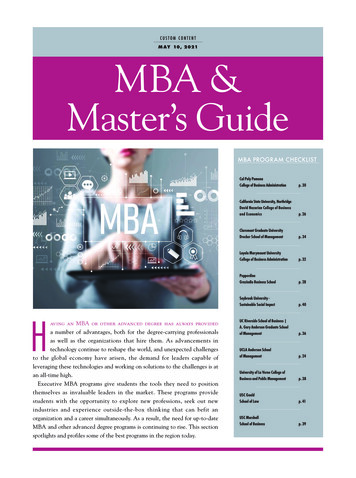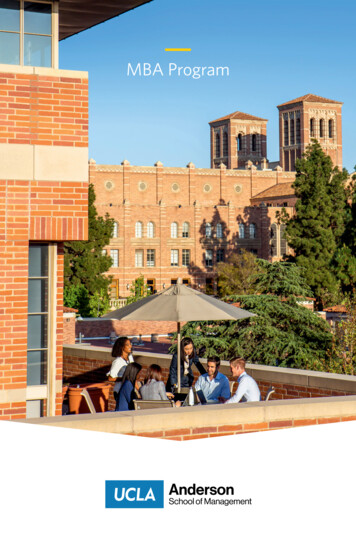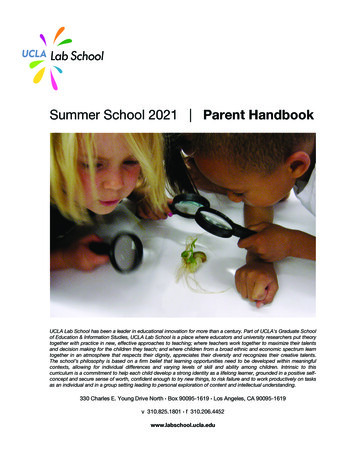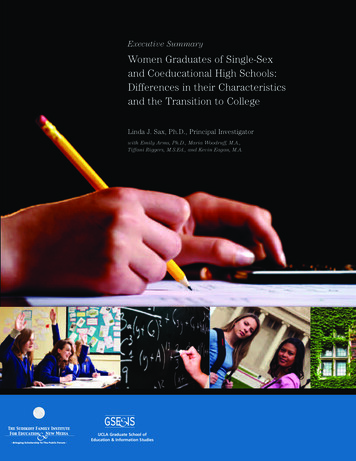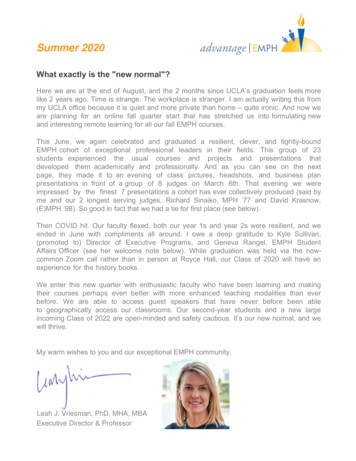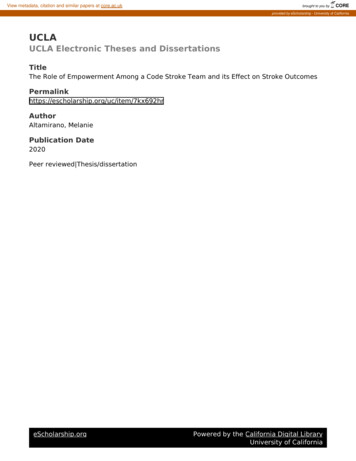
Transcription
UCLA School of Law’s Frank G. Wells EnvironmentalLaw Clinic offers excellent opportunities for students to obtain hands-on experiencepracticing environmental law. Students who take this six-unit course work on large and smallcases, involving both federal and state law. The clinic teaches conceptual frameworks thatsupport particular lawyering skills, while at the same time exposing students to real-worldenvironmental law practice through intensive work on particular environmental issues. Inthis way, the clinic trains the next generation of environmental lawyers.UCLA School of Law, 405 Hilgard Avenue, Los Angeles, CA 90095www.law.ucla.edu/environment envirolaw@law.ucla.eduSurfrider Foundation is a nonprofit grassroots organization dedicated to theprotection and enjoyment of our world’s ocean, waves and beaches through a powerfulnetwork. Founded in 1984 by a handful of visionary surfers in Malibu, California, the SurfriderFoundation now maintains more than one million supporters, activists and members, withover 160 volunteer-led chapters and student clubs in the U.S., and more than 500 victoriesprotecting our coasts. In 2007, the organization’s Rise Above Plastics program was foundedto reduce impacts of single-use plastics on the marine environment by raising awarenessabout the dangers of plastic pollution and advocating for a reduction of single-use plasticsand the recycling of all existing plastics.Surfrider Foundation, PO Box 73550, San Clemente, CA 92673www.surfrider.org www.riseaboveplastics.org legal@surfrider.org
I.INTRODUCTIONGlobal plastics pollution is on the rise. Despite efforts by the federal, state, and local governments to addressaspects of this issue, the problem remains significant. Not only does plastic pollution raise environmental andpublic health concerns, but it has serious economic impacts as well: plastic pollution impacts our food supplyand the tourism industry along America’s over 12,000 miles of coastline.In 2015, through a bipartisan effort, Congress successfully passed legislation regulating plastic microbeads—the Microbead-Free Waters Act of 2015—recognizing the significant harms they pose to the environment andto wildlife. By the time federal legislation was passed, cities and states, including California, New York, andIllinois, had already taken action on banning plastic microbeads, creating a hodgepodge of regulation andprompting federal action. The tourism, fishing, and cosmetics industries had expressed support for state andlocal bans and, in some cases, had already instituted private efforts to eliminate the use of plastic microbeads.The Microbead-Free Waters Act was a strong federal solution that stabilized conditions for manufacturers,protected industry, and prevented further environmental harms from microbeads. Moreover, as the first country to ban plastic microbeads, the Act established the United States as a global leader in reducing plasticpollution.Unfortunately, the plastic problem remains unsolved and requires additional strong federal action. While the Microbead-Free Waters Actaddressed plastic microbeads, it left unregulated another large source ofplastic pollution: single-use plastics, such as plastic bags, plastic straws,and plastic bottles. Single-use plastics, much like plastic microbeads,pose significant threats to the environment and to wildlife. Turtles oftenmistake single-use plastic bags for jellyfish and eat the plastic bags.Moreover, single-use plastics often break down into microplastics thatare the same size as—or even smaller than—federally-banned plasticmicrobeads. Hundreds of fish and seabird species consume these plastic particles; 268,940 tons of them are currently floating at sea.1 Manyof the fish species that consume plastics, like Bigeye Tuna, end up onPlastic pollution has a direct, deadlyeffect on marine ecosystems, mainlydue to the fact that animals confusecommon plastic items, especiallybags, with food, often ending upinjured, entangled, or dead.American dinner plates. And recent studies have found that 90% of alltable salt contains microplastics—making plastic firmly a part of the average American’s diet.Just like microbeads, single-use plastics can also cause significant economic losses for the tourism industry when beaches are closed and littered with plastic pollution. But they also have a worse economic impactthan microbeads: they cost municipalities and states millions of dollarsevery year. In total, governments spend between 3.2 and 7.9 billionevery year just to control plastic bag litter.2 As a result, several statesand municipalities have created plastic bag bans and hybrid bag bans and fees, resulting in a patchwork ofregulations that dwarfs the amount of state and local action on microbeads prior to Congress’ 2015 action.Industries have also already initiated efforts to reduce single-use plastic consumption after recognizing thesignificant harms from single-use plastics—for example, Carlsberg Brewery, which distributes beer in theUnited States, has announced that they will stop using plastic multi-pack rings for beer cans. Nor would theUnited States be alone in addressing this problem if Congress were to act: several countries have alreadyenacted national single use plastic bag bans.Like plastic microbeads, the harms from single-use plastic bags to government, industries, the environment,human health, and wildlife require swift and strong federal regulation. Successes from policies enacted atFederal Actions to Address Marine Plastic Pollution1
the local and state level can provide a model for federal regulation. California’s ban/fee hybrid on all carryoutbags has achieved great success in reducing single-use plastic bag use by influencing consumer behavior. Thesuccess of California’s statewide ban demonstrates that Congress can adopt a nation-wide policy that woulddiminish the harms from single-use plastic by reducing the production and consumption of plastic bags. Policies enacted in other countries also serve as examples of regulatory options and corroborate the success ofregulations implemented domestically.This briefing booklet will provide background information on single-use plastics and their associated harms,demonstrate the need for federal action, analyze enacted single-use plastic regulations both domestically andinternationally, and provide federal policy recommendations to address the single-use plastic crisis. Becauseof the unique environmental harms and economic costs associated with single-use plastic bags, and because somany state and local governments have taken action to address them, this briefing booklet will focus in-depthon strategies to reduce consumption of single-use plastic bags nationwide but will also discuss federal actionsthat can operate in tandem with plastic bag-focused legislation to reduce consumption of other single-use plastic products.II. BACKGROUNDA. Single-Use Plastic Waste GenerallyGlobal plastic production and the consequent plastic waste generation has increased from almost 5million tons per year during the 1950s to over 280million tons in 20093 and today exceeds 300 million tons per year4. The majority of plastic is usedto make single-use items, which are disposed ofwithin a year of production. These single-use plastics are typically used only once before they arethrown away or recycled, and they include plasticbags, cigarette butts, cutlery, plates, straws, stirrers,bottles and caps, food wrappers, and plastic andfoam packaging5. Based on 2015 figures, the UnitedStates was the largest generator of plastic packagingFig. 3. Cumulative plastic waste generation and disposal (in million metric tons). Solid lines show historicaldata from 1950 to 2015; dashed lines show projections of historical trends to 2050waste on a per-capita basis.6 Considerable quantities of these single-use plastics are accumulating inlandfills and waterways. The natural capital cost ofplastic use from the consumer goods sector alone is 75 billion. The natural capital cost represents the scale ofenvironmental damage and social impacts in monetary terms. 13 billion of the natural capital costs are tied tothe impacts on marine ecosystems, which are significantly tied to single-use plastic bags. Each year, about 18billion pounds of plastic waste enter the worlds’ oceans from coastal regions.7 The quantity of single-use plastics in the marine environment is abundant and widely distributed in the oceans, causing immense harm to theecosystem. These plastics also progressively fragment into small pieces, known as microplastics, which neverfully disappear,8 because these plastics are not fully biodegradable9.B. Marine Plastic DebrisSingle-use plastic products become litter and end up in waterways, flowing downstream into the oceans, wherethey eventually become marine debris. A recent estimate projects that 8.8 million tons of plastic enters theocean every year.10 Once plastics find their way into the oceans, they often remain there for decades or longer,Surfrider Foundation & UCLA Wells Environmental Law Clinic2
making them the most serious and persistent form of marine debris. In some regions, plastics account for 9095% of marine litter; plastics make up about 60-80% of all marine debris globally.11Marine plastic debris can come from either land-based or ocean-based sources. Land-based sources of plasticdebris contribute 80% of the total plastic debris in the marine environment, with densely populated or industrialized areas being the major sources because of littering, plastic bag usage and solid waste disposal.12 In otherwords, poorly-managed waste on land results in the great majority of marine plastic pollution. Ocean-basedsources account for the remaining 20% of marine plastic debris, to which commercial fishing is the major contributing human activity.13The problem of marine debris is large and growing every day. “The numbers are staggering: There are 5.25trillion pieces of plastic debris in the ocean. Of that mass, 269,000 tons float on the surface, while somefour billion plastic microfibers per square kilometer litter the deep sea.”14 Over time, ocean currents bringtogether enormous quantities of plastic waste on the surface of the sea, forming vast “ocean gyres” such asthe “North Pacific Gyre,” known as the “Great Pacific Garbage Patch.”C. Plastic Waste and WildlifeAll of this plastic is causing harm to the marine ecosystem, from coralreefs smothered in bags; to turtles choking on straws; to whales andseabirds that starve because their stomachs are full with plastic items,leaving no space for real food.15 Recent studies indicate possible longterm impacts from plastic on the marine food chain, raising seriousquestions about the ultimate impact of this marine plastic debris onhuman health and food security.16Plastic pollution has a direct, deadly effect on marine ecosystems,mainly due to the fact that animals confuse common plastic items, especially bags, with food, often ending up injured, entangled, or dead.In total, governments spend between 3.2 and 7.9 billion every year justto control plastic bag litter.Multiple examinations of dead fish, mammals, birds, turtles, and squidhave shown traces of ingested plastic debris. In birds, ingested marinedebris has been reported to cause reductions in nutrient absorption andin the amount of space for food, ulceration of tissues, and mechanicalblockage of digestive processes. Entanglement makes movement, feeding, and growth of marine animals difficult or even impossible.17 Fish,marine mammals, and seabirds are being injured and killed by plastic pollution, and it is estimated that thiscould force many species – including endangered wildlife – into extinction (e.g. the Hawaiian monk seals andthe Pacific loggerhead sea turtles).18 At least 700 species worldwide have already been affected, including84% of sea turtle species, 44% of all seabird species, and 43% of all marine mammal species, and approximately 25% of fish sold at markets in California contained plastic in their guts, mostly in the form of plasticmicrofibers.19Toxic compounds from plastics are absorbed by the organisms that ingest them, impacting marine, and ultimately human, life. Scientists have found that these chemicals have detrimental effects to the immune system, thereproductive system, development, neurological responses and the overall growth of organisms, and can causetumor development and liver problems in animals.20 Bisphenol A, or BPA, which is found in many plasticsentering the ocean, acts as an endocrine disruptor for fish. Freshwater fish exposed to BPA have exhibited confusion and difficulty mating. Plastic pollution is also impacting gender in some fish species (chemicals are foundto cause feminization of male fish or have caused fish to become intersex due to BPA exposure).21Federal Actions to Address Marine Plastic Pollution3
D. Human Health ConsequencesPlastic pollution in the marine environment has a direct impact on human health.22 Fish consume plasticswhich may carry a variety of chemicals and pollutants, such as PCBs and heavy metals, depending on howlong they have been floating in the water. The absorption of these chemicals from ingested plastic triggersconsecutive transfers of the chemicals from fish to the bodies of animals higher up in the food chain, including humans, who are exposed to various chemicals through the consumption of fish and seafood,23 aswell as through consumption of other meat that has been fed fishmeal. It has been reported that plastics andthe various additives contained therein such as plasticizers, stabilizers, flame retardants and colorings, someof which are toxic, bioaccumulative, and persistent in the environment, are associated with several humanhealth concerns, including disruption of the endocrine and reproductive systems, infertility, and possiblywith some types of cancer.24 For example, BPA, which is still used in plastic food service products, has beenclassified as an endocrine disruptor, and laboratory and epidemiological studies suggest links between BPAexposure and reduced fertility, altered timing of puberty, and changes in mammary gland development; BPAexposure in utero or to children has been linked to adverse neurodevelopmental outcomes and childhoodobesity.25 Furthermore, plastic pollution also threatens the health and security of beach visitors and divers,including by fouling propellers and jet intakes of commercial and recreational boaters.E. Single-use Plastics and Climate ChangeApart from the impacts on the environment, on wildlife and on human health, plastics are also associated with carbon pollution, andconsequently with climate change. From materials extraction to product production and waste disposal, plastics emit green-house gases.Conventional plastic is made from fossil fuels.26 Natural gas liquids(NGLs) ethane and propane get extracted and sent to a “cracking facility” where ethane is made into ethylene, and at a dehydrogenationplant, propane is made into propylene.27 Polyethylene, an ethylenecompound, is the most common plastic in the world and is frequentlyused for packaging, bottles, synthetic clothing, and for making plasticbags. Polypropylene, a propylene compound, is a plastic commonlyfound in food packaging and vehicle manufacturing.Apart from the impacts on theenvironment, on wildlife andon human health, plastics arealso associated with carbonpollution, and consequentlywith climate change.As the fossil fuel industry is investing in the expansion of the petrochemicals business, plastic production is projected to triple by 2050.Petrochemicals are by far the largest driver of global oil demand growthand thus, the largest industrial energy consumer, and the third-largest industrial emitter of greenhouse gas emissions. A recent report ofthe International Energy Agency estimates that direct greenhouse gasemissions from petrochemicals will increase 20% by 2030 and 30%by 2050, with the main driver of the petrochemical industry’s growingclimate footprint being plastic production.28Furthermore, according to recent studies, plastics emit greenhousegases - in particular methane and ethylene - as they degrade in sunlight.29 Methane as a gas can trap heatroughly 30 times more than carbon dioxide. Polyethylene is considered the worst offender.III. THE NEED FOR FEDERAL ACTIONA. Economic Benefits of Plastics RegulationGiven the practical challenges of removing decades of accumulated plastics from the oceans, it is clearthat source reduction and prevention, in addition to remediation, is critical. Single-use plastics harm theeconomy, creating significant costs for industry and for government. Controlling the manufacture and useof single-use plastics prior to disposal is necessary.Surfrider Foundation & UCLA Wells Environmental Law Clinic4
Single-use plastic bags cause particular harm: they are a resource-intensive product made from natural gas or petroleum, yet are often usedfor mere minutes before being disposed of.30 Plastic bags are frequentlylittered and float easily and freely through the air and water, cloggingstormwater drainage systems and public waterways. The cleanup costsof plastic bag litter are significant for local governments; across theUnited States, governments spend between 3.2 and 7.9 billion annually on plastic bag litter control alone.31 Moreover, the majority of plastic bags are not recycled, creating additional costs to landfill discardedplastic bags; California, for example, spends 25 million every year tolandfill discarded plastic bags.32 Indeed, single-use plastic bags are dif-Congress can take action to createboth economic and environmentalbenefits by banning single-useplastic bags or placing a fee onall single-use bags. Studies onexisting bag bans and fees haveshown that they are effective inchanging consumer behavior andhave a beneficial environmentaland economic impact.ficult to recycle. Recycling companies incur significant costs as a resultof plastic bags’ impact on machinery: they gum up recycling machines,temporarily halting operations. Plastic bag litter heavily impacts otherindustries as well. The tourism and coastal hospitality sectors, in particular, are harmed by single-use plastic litter, which can shut down beaches.The common practice throughout the United States has been to distributeplastic bags for free along with purchases at various retail stores. Althoughtoday the single-use plastic bag is omnipresent, it is a relatively recentaddition to the retail experience; its high popularity derives from its lightweight and its perceived low cost. Globally, it is estimated that two million single-use plastic bags per minute are distributed at store checkoutcounters.33 The waste and pollution that results from these vast quantitiesof single-use plastic bags has devastating environmental impacts.Congress can take action to create both economic and environmental benefits by banning single-use plastic bags. Studies on existing bag bans haveshown that bag bans are effective in changing consumer behavior and havea beneficial environmental and economic impact. After Washington D.C. banned carryout bags, there was a72% reduction in the number of bags found in waterways. 80% of D.C. residents used fewer disposable bags,and 79% of businesses provided fewer disposable bags. Overall, in D.C., there has been an 85% reduction inplastic bag consumption.Addressing single-use plastic bags will be economically beneficial for local and state governments. Currently,the estimated annual direct costs of plastic debris management ranges from 8.9 to 18.33 per capita. However,in certain communities, costs can be far more significant; for example, the City of Del Mar, California pays anannual cost of 71.22 per capita to manage plastic debris. California alone spends almost half a billion dollarsannually just to combat plastic litter and prevent the entry of that litter into waterways.34 Reducing this litter bybanning single-use plastic bags will consequently dramatically reduce government costs for plastic litter controland debris management. California’s statewide ban on plastic bags has resulted in a 72% reduction in plastic baglitter; such litter now accounts for less than 1.5% of all litter. San Francisco has saved up to 600,000 annuallyon plastic processing fees since the enactment of its plastic bag ban. Additionally, some municipalities havebeen able to offset their plastic-related costs by charging a fee for single-use bags. For example, the City of Aspen enacted an ordinance that banned single-use plastic bags and charged for all carry-out bags. While retailerswere allowed to keep a portion of the collected fee, the remaining amount was remitted to the city governmentfor their waste reduction and recycling program, which benefitted all Aspen residents.Federal Actions to Address Marine Plastic Pollution5
Industries also benefit from bans on single-use plastics. United States retailers, like grocery stores, currentlyspend 4 billion annually to purchase 100 billion plastic bags for single use, but will have to spend muchless to provide bags to customers once a ban on single-use bags is implemented. Retailers can also recoupsome of their expended costs by imposing a fee on carry-out bags. Reducing plastic litter will also have apositive impact on the coastal hospitality and tourism sector, which generated 93 billion in 2010. Economiclosses to coastal businesses as a result of plastics-related interference can range from 15-40%; for example, thecost of closing a Lake Michigan beach because of pollution is 37,030 per day. These costs would be avoidedif single-use plastics were properly regulated.Some consumer goods companies have found it beneficial to implement their own policies to manage plasticwaste; indeed, consumer good companies that have implemented plastic management programs have saveda collective 4 billion. Half of these savings is tied to better management of single-use plastics in packagingin the retail, soft drinks, and food sectors. Recently, a number of companies in these spaces have announcedinitiatives to reduce their reliance upon single-use plastics; for example, Starbucks plans to eliminate its use ofplastic straws by 2020, and Dunkin’ Donuts has pledged to phase out all Styrofoam cups from its global supplychain in the same time period.35 A Harvard Business School Study found that companies that enacted sustainability policies, including policies on plastics reduction and recycling, outperform other companies in the stockmarket over the long-term.36 Some companies have also already found that reduction in plastic use can result inbrand popularity and loyalty. Private initiatives from large companies like United Airlines, Starbucks, Dunkin’Donuts, Shake Shack, Carlsberg Brewery, and Red Lobster to reduce reliance on single-use plastics signal thatthere can be economic boosts from limiting plastic use. However, these kinds of company-led efforts to manage plastic waste are by no means universal; federal legislation is needed to level the playing field and ensurethat appropriate steps to reduce plastic consumption and waste are being taken.B. Types of State and Local Single-use Plastic Reduction EffortsMany states and local governments in the U.S. have long been concerned with reducing the use of plastics andhave come up with different measures to address the issue. These measures include existing plastic bag laws,extended producer responsibility, and recycling.i. Types of Domestic Plastic Bag Laws Straight Bag Ban: Retailers are prohibited from offering plastic single-use bags at the point of sale. A“straight” plastic bag ban generally means that thin plastic bags are banned; however, this often results inshifting consumers to other single-use items, as long as these are provided for free (e.g. paper bags andthicker plastic bags that qualify as “reusable bags”), with negative outcomes. Such a measure is also easyto bypass by simply upping the thickness of plastic bags to qualify as “reusable” bags. Bag Fee: Fee mandated for all carryout bags. It can be a minimum fee or a flat fee, with the minimum feeallowing for retailers to provide different types of carryout bags at varying prices, and allowing businessesthat have already adopted stricter bag policies to continue implementing them. Hybrid Ban/Fee: The so-called “second generation” ban, consisting of a ban on thin plastic bags and afee for all other carryout bags (paper, reusable, compostable). Recycling Laws: Legislation related to labeling, recycling, and reusing plastic bags has been in force inseveral U.S. states for decades. Maine was the first state to adopt legislation in 1991 requiring recyclingefforts from the retailers; the law prevents retailers from supplying plastic bags unless they provide storefront means for the collection and recycling of used bags. Since then, this example has been followed byCalifornia, Delaware, New York and Rhode Island, and the District of Columbia.The bag fee and hybrid ban/fee strategies have proven to be the most effective in changing consumer behaviorand reducing carryout bag consumption.37ii. Other Domestic Single-use Plastic BansA number of state and local governments have also taken action to reduce consumption and disposal of othersingle-use plastic items through the enactment of targeted bans, which include:Surfrider Foundation & UCLA Wells Environmental Law Clinic6
Bans of Plastic Straws, Stirrers, Utensils, and Cups: Plastic straws and other carryout plastics, like single-use plastic bags, are ubiquitous and create many of the same environmental and human health harmsand economic losses for governments and industries. Several local governments have passed laws banningthe use of plastic straws, stirrers, and other utensils, or requiring that such items only be offered upon acustomer’s request, and states are beginning to follow suit. These laws are sometimes called comprehensivefoodware policies, because they address a wide range of single-use foodware packaging. Bans on Expanded Polystyrene (a.k.a. StyrofoamTM): EPS foamimplicates different human health concerns from single-use plasticbags. Hot, greasy, or acidic foods can make the synthetic chemicalsand the fossil fuels that are used to make EPS foam leach out into food,allowing them to be consumed by humans. There is no economicallyfeasible or environmentally effective system for recycling polystyreneand consequently most single-use foam items are either sent to landfills or littered.38 During a three-day survey of plastic items floating tothe ocean in Los Angeles, researchers found that 71% of the 2.3 billion plastic items of marine debris were expanded polystyrene foam.39Hundreds of local jurisdictions have banned retailers and manufacturersfrom selling or using polystyrene packaging, and a number of juris-Recycling does not tackle theproblem of marine plastic pollutionat its source and for many plasticsis not a viable solution.dictions have prohibited food service businesses from distributing EPScontainers and food service products to customers. Cigarette-free Beach Laws: Cigarette butts have consistently beenreported as the most common item found on beaches during the International Coastal Clean Up Day. Over 300 local jurisdictions in the UnitedStates, as well as some states, have banned smoking on beaches in aneffort to reduce the amount of cigarette litter and smoke exposure inthese spaces. Some jurisdictions have also banned smoking in other public spaces, such as public parksand walkways.iii. Extended Producer ResponsibilityExtended Producer Responsibility (EPR) is a producer-end mechanism for decreasing waste, particularly plasticwaste, usually by increasing recycling and decreasing dependency on raw materials. EPR shifts the cost of managing post-use products partially or fully from local governments to the producing industry.40 EPR is based on the“polluter pays” principle, which makes those who produce the waste responsible for its reuse, recycling and/or disposal. Requiring industry to take back products at the end of their useful lives incents industry to design productswith a mind to enhanced reusability.41 In this way, EPR is similar to product liability law.42 EPR laws for packagingserve as a means to divert waste from entering landfills and to increase recycling of reusable materials, therebydecreasing sources of marine pollution.In the U.S., the federal government has a limited role in municipal solid waste (MSW) management. It providestechnical assistance, establishes minimum solid waste landfill criteria and it regulates waste-to-energy facilities.This allocation of power can prevent local governments from enacting EPR laws; however, local governments havedeveloped other mechanisms to reduce disposal of MSW and are tackling single-use plastic bag pollution througha combination of bans, taxes and fees, specified bag design, consumer education, and mandated retailer take back.43iv. RecyclingRecycling does not tackle the problem at its source and for many plastics is not a viable solution. Single-useplastics can be challenging and costly to recycle, and despite plastic products having been in use for over 50Federal Actions to Address Marine Plastic Pollution7
years, the U.S. lacks the necessary infrastructure to efficiently manage this resource-intensive process. Whensingle-use items like plastic bags and straws reach recycling facilities, they often jam and damage the sortingmachines, and some single-use plastics, like EPS foam, cannot be recycled cost-effectively at all.44 Manyplastics—like single-use plastic bags—cannot be recycled into a widely re-usable plastic material.Plastics recycling is fraught with humanitarian issues, and is causing a dire domestic waste managementproblem. Since it is so expensive to recycle plastics, the United States has long relied on sellin
making them the most serious and persistent form of marine debris. In some regions, plastics account for 90-95% of marine litter; plastics make up about 60-80% of all marine debris globally.11 Marine plastic debris can come from either land-based or ocean-based sources.
